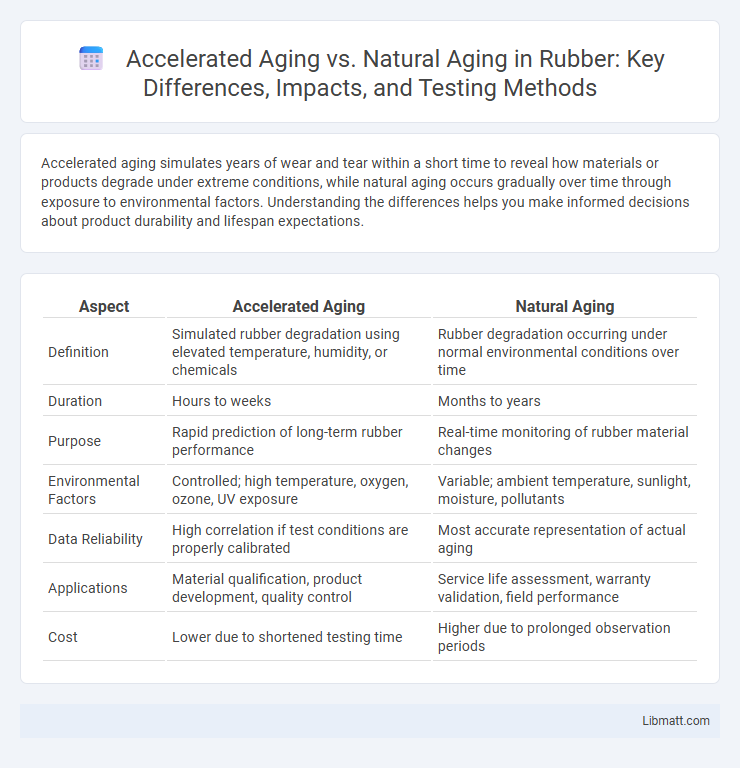Accelerated aging simulates years of wear and tear within a short time to reveal how materials or products degrade under extreme conditions, while natural aging occurs gradually over time through exposure to environmental factors. Understanding the differences helps you make informed decisions about product durability and lifespan expectations.
Table of Comparison
| Aspect | Accelerated Aging | Natural Aging |
|---|---|---|
| Definition | Simulated rubber degradation using elevated temperature, humidity, or chemicals | Rubber degradation occurring under normal environmental conditions over time |
| Duration | Hours to weeks | Months to years |
| Purpose | Rapid prediction of long-term rubber performance | Real-time monitoring of rubber material changes |
| Environmental Factors | Controlled; high temperature, oxygen, ozone, UV exposure | Variable; ambient temperature, sunlight, moisture, pollutants |
| Data Reliability | High correlation if test conditions are properly calibrated | Most accurate representation of actual aging |
| Applications | Material qualification, product development, quality control | Service life assessment, warranty validation, field performance |
| Cost | Lower due to shortened testing time | Higher due to prolonged observation periods |
Introduction to Aging: Accelerated vs Natural
Aging is a biological process characterized by the gradual decline of cellular and physiological functions over time. Accelerated aging occurs due to genetic factors, environmental stressors, or unhealthy lifestyle choices that speed up this decline, while natural aging follows the typical timeline influenced by genetics and normal metabolic processes. Understanding the distinction between accelerated aging and natural aging can help you adopt targeted strategies to promote healthy longevity.
Defining Accelerated Aging
Accelerated aging refers to the rapid decline in biological and physical functions that typically occurs due to external stressors like pollution, radiation, or unhealthy lifestyle choices, distinguishing it from the gradual process of natural aging. Unlike natural aging, which follows a predictable timeline controlled by genetic and environmental factors, accelerated aging speeds up the deterioration of cells and tissues, often leading to early onset of age-related diseases. Understanding the mechanisms behind accelerated aging helps you take proactive steps to slow down its effects and maintain long-term health.
Understanding Natural Aging Processes
Natural aging involves gradual biological changes such as cellular senescence, reduced collagen production, and DNA damage accumulation, which collectively impact skin elasticity and organ function. Accelerated aging occurs when environmental factors like UV exposure, pollution, or poor lifestyle choices intensify these processes, leading to premature wrinkles, cognitive decline, or weakened immune response. Understanding natural aging processes helps you make informed decisions to minimize damage and enhance overall health longevity.
Key Differences Between Accelerated and Natural Aging
Accelerated aging involves artificially induced environmental factors such as UV radiation, temperature, and humidity to simulate long-term degradation within a shorter timeframe, whereas natural aging occurs through gradual exposure to real-world conditions over extended periods. Key differences include the speed of aging processes, with accelerated aging providing rapid insights into product durability and material stability, while natural aging offers authentic but time-consuming data reflective of real-life use. Accelerated methods enable prediction of lifespan and performance under stress, contrasting with natural aging that documents organic wear and deterioration.
Causes and Risk Factors of Accelerated Aging
Accelerated aging is primarily caused by factors such as chronic stress, excessive sun exposure, smoking, poor diet, and environmental pollutants that increase oxidative stress and cellular damage. Genetic predispositions, lifestyle habits, and exposure to toxins amplify these risk factors, resulting in premature wrinkles, reduced skin elasticity, and organ decline beyond natural aging processes. Your ability to mitigate these causes through healthy habits and protective measures significantly influences the pace of aging.
Biological Markers of Aging
Biological markers of aging, such as telomere length, DNA methylation patterns, and levels of oxidative stress, differ significantly between accelerated aging and natural aging processes. Accelerated aging often shows heightened cellular senescence and inflammation, leading to premature decline in tissue function compared to the gradual and more regulated changes observed in natural aging. Monitoring biomarkers like mitochondrial dysfunction and inflammatory cytokines helps distinguish pathological acceleration from the typical chronological progression of aging.
Impact of Lifestyle on Aging Speed
Accelerated aging occurs when poor lifestyle choices such as smoking, excessive alcohol consumption, inadequate sleep, and chronic stress increase oxidative stress and inflammation, leading to premature cellular damage. Natural aging progresses at a slower rate when balanced nutrition, regular exercise, and proper hydration support the body's repair mechanisms and maintain telomere length. Your lifestyle habits critically influence the biological aging process, determining whether you experience accelerated decline or healthy longevity.
Health Consequences of Accelerated Aging
Accelerated aging significantly increases the risk of chronic diseases such as cardiovascular disorders, diabetes, and neurodegenerative conditions by causing cellular damage and systemic inflammation at a faster rate than natural aging. Your body's immune response weakens prematurely, leading to impaired tissue repair and heightened vulnerability to infections. Understanding these health consequences is crucial for implementing lifestyle changes that may slow down the accelerated aging process and reduce associated risks.
Prevention and Intervention Strategies
Prevention and intervention strategies for accelerated aging emphasize lifestyle modifications such as balanced nutrition, regular physical activity, and stress management to reduce oxidative stress and inflammation. Targeted medical treatments, including antioxidants, hormone replacement therapy, and advanced skincare regimens, help mitigate cellular damage and improve tissue regeneration. Monitoring biomarkers through personalized health assessments enables you to identify early signs of accelerated aging and implement effective interventions to maintain optimal aging trajectories.
Future Research and Perspectives on Aging
Future research in aging aims to unravel molecular mechanisms differentiating accelerated aging from natural aging, emphasizing biomarkers for early detection and intervention strategies. Advances in gene editing, regenerative medicine, and personalized therapies promise to alter aging trajectories, potentially extending healthy lifespan and mitigating age-related diseases. Your engagement with emerging technologies and lifestyle modifications will be crucial in adapting to these transformative perspectives on aging.
Accelerated Aging vs Natural Aging Infographic

 libmatt.com
libmatt.com